What is a Title Tag, and How to Optimize It? (Title Tag in Hindi) (Length, Generator, Optimizations)
If you’re a blogger, you likely know what a title tag is. However, many bloggers, despite knowing what a title tag is and its importance for their blog post, make mistakes in writing it, leading to their blog not ranking well in Google’s search engine. Is this happening to you too? If yes, then I will provide you with all the information about title tags in this article.
The title tag acts as the face of your blog post to Google’s bots and any visitor. In other words, when Google’s bots or a visitor comes to your blog, the first thing they see is your title tag. The title tag tells them what the article is about. From an SEO point of view, the title tag is very important.
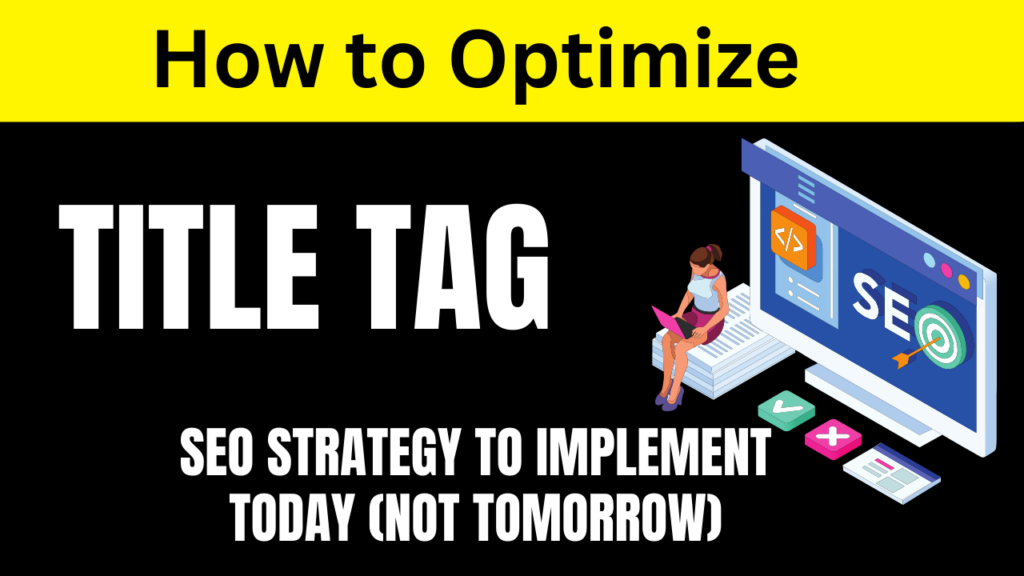
Without a title tag, your article is incomplete. Almost all bloggers use title tags in their posts.
Have you ever noticed that when all bloggers use title tags, only a few of their articles rank in Google’s search engine, but not the rest? Do you know why? Let me tell you, it’s because those bloggers do not write their title tags well, resulting in their articles not ranking.
If you make the same mistake, it could be problematic for your blog. But don’t worry, in this article, you’ll find solutions to all your problems.
In this article, I will provide you with all the information related to title tags, what a title tag is, why it is important for SEO, and how to optimize a title tag. So, this article is going to be quite interesting, make sure not to miss any point.
So, let’s start with what a title tag is.
What is Title Tag
A title tag works as an HTML element, meaning it’s a header section in any web page where the title is written. The title tag can be used in any type of website. It informs any visitor about what they will find in that article.
For example, if you search in google “Google search operators complete guide deepawaliseotips” then you would see the below screenshot as search result.
Boc marked below are the title tag. Be aware that title tag can be different from post title and is mainly to display users on what your post is all about.
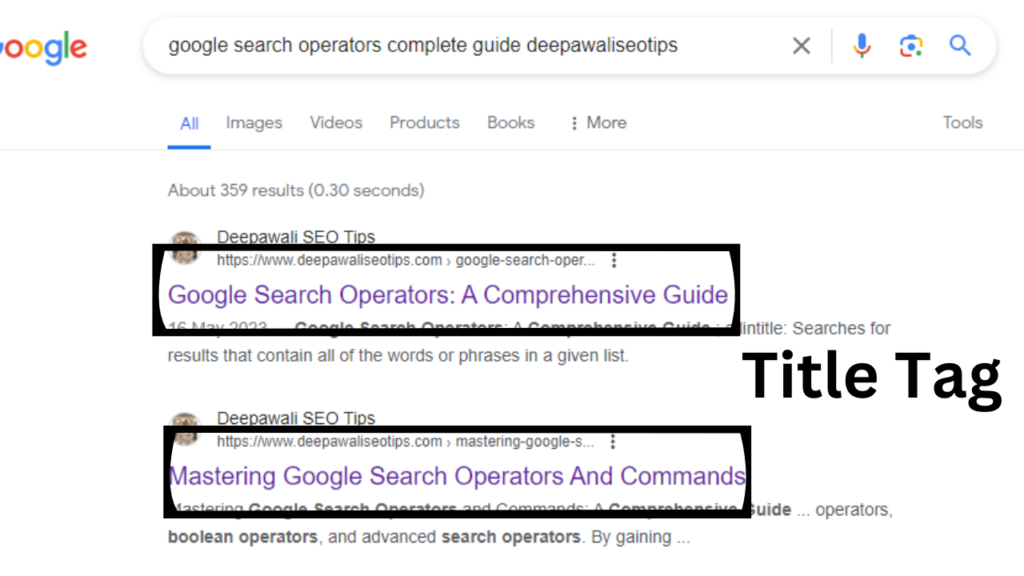
Without it, posting on your website won’t benefit you. The title of any post is visible to the user in the browser. The title tag is a crucial element that helps search engines understand the post.
According to searching keywords, your page will get ranked based on the title. It is from this that organic traffic comes to your page. The titles in every web page post are entirely unique.
Just as doctors are tagged as doctors and engineers as engineers, similarly, any blog is given a title tag. Just as a person’s name is important to them because it identifies them, similarly, the HTML title tag is very important for any article, blog post, or page.
If you use the same type of title for every post on your website, change it today. This could be a main reason why your website isn’t getting traffic.
I hope now you have a good understanding of what is title tag,
Importance of Title Tag
Bringing traffic to their blog is not at all easy for a blogger. They keep optimizing according to SEO to ensure they get a good ranking in the search engine.
In on-page SEO, both the title tag and meta description are crucial elements. The title tag serves the purpose of defining any page.
The title tag is written in the form of an H1 heading. Just as keywords, internal linking, heading tags, external linking, formatting, etc., are important in any article, similarly, the title tag is very crucial.
How to search for a Title Tag in search engines?
Now you have understood what a Title Tag is and why it’s important. Let’s learn how to search for a Title Tag in search engines. Whenever you search for a topic or keywords in a search engine, you see links to many websites in blue color; that’s the Title Tag. You can check the above image which shows what a title tag looks like.
Right below it, the data written in light color is called the Meta description. You can set a specific title and meta in the Meta title tag and Meta description if you want.
By doing this, the set title and meta will be displayed in the search engine. If you haven’t set it, the search engine will pick up the normal title of your post and show it as the Title.
This improves the ranking of your website. Google will give your blog post a good ranking in the eyes of SEO.
However, if you’re looking to see the specific title tag of a webpage or check how it’s written, you can do so by viewing the page source or using browser developer tools. Here’s how:
- View Page Source:
- Navigate to the webpage in your browser.
- Right-click anywhere on the page and select “View Page Source” or similar (the exact wording may vary by browser).
- In the page source, search for
<title>tag. The text within this tag is the title tag of the page.
- Use Browser Developer Tools:
- Open the webpage in your browser.
- Right-click and select “Inspect” or press
Ctrl+Shift+I(Windows) orCmd+Opt+I(Mac) to open the developer tools. - Locate the
<title>tag within the “Elements” tab. The content inside this tag is the webpage’s title tag.
Remember, the title tag is crucial for SEO as it gives search engines and users a brief idea about the content of the webpage. It appears as the clickable headline for a given result in the search engines and is considered one of the most important on-page SEO elements.
> Google Adsense Approval Full Guide
Where is the Title Tag displayed?
The Title Tag is displayed in several key places:
- Search Engine Results Pages (SERPs): The most visible place where the title tag is displayed. It appears as the clickable headline for the listings on search engine results pages.
- Web Browsers: The title tag is shown in the browser tab or window title, helping users identify the content of the page they are on.
- Social Media: When a page is shared on social media platforms, the title tag is often used as the title of the shared content.
- Bookmarks: When a user bookmarks a page, the title tag is used as the default name of the bookmark, making it easier for users to find and remember the page later.
Title tag optimization
What a Title Tag is, why it is important, and how to optimize the Title Tag after searching it in a search engine is also very important to know. As I have already mentioned, if you do not properly specify the Meta title tag and Meta description in any of your posts,
The search engine will by default pick up any line according to the search keywords from your article post and show it as a title. This is wrong according to the rules of SEO.
If you want to maintain a good ranking for your website, optimizing your Title Tag is very important.
Ensure in your blog that the Meta title tag and Meta description are set according to SEO. By doing this, the search engine will only show the set title and meta in the search results.
Including the necessary keyword in the title is very important. You should insert the keyword that is the main topic of your article. This keyword will help in achieving a good ranking in the search results.
How to Set the Meta Title Tag?
Setting the Meta Title Tag involves a few straightforward steps, typically done through your website’s content management system (CMS) or directly in the HTML code if you’re working with a static website. Here’s how you can do it:
- For CMS Users (e.g., WordPress, Joomla, Drupal):
- Navigate to the page or post editor within your CMS.
- Look for the SEO settings section; this might be part of the CMS itself or available through an SEO plugin like Yoast SEO or All in One SEO.
- Find the field labeled as “SEO Title,” “Meta Title,” or simply “Title Tag” and enter your desired title.
- Save or update your changes, and the new title tag will be set for that page or post.
- For Static Websites:
- Open the HTML file of the page you want to edit in a text editor.
- Locate the
<head>section of the HTML document. - Find the
<title>tag. If it doesn’t exist, you can add it within the<head>section. - Replace the content between the
<title>tags with your desired title. For example:<title>Your New Title Tag Here</title>. - Save your changes, and upload the updated file to your server if necessary.
Tips for Effective Meta Title Tags:
- Keep your title simple but descriptive; ideally, between 50-60 characters to ensure it displays well in search results.
- Include relevant keywords towards the beginning of the title.
- Make sure the title is relevant to the page content and provides a clear idea of what the page is about.
- Avoid keyword stuffing and ensure the title is appealing to human readers.
By following these steps and tips, you can effectively set and optimize your meta title tags, contributing to improved SEO and click-through rates from search engine results pages.
Points to Keep in Mind when setting Title Tag
- Only a blogger truly understands the importance of keywords. If you’ve written many articles but haven’t added the main keywords, it’s like serving good-looking food without any salt. Therefore, always include the main keywords in the meta title and description whenever you write an article.
- When creating Meta Titles or HTML Title Tags, also ensure that you do not over-stuff your title with keywords. This could excessively lengthen the title and make it unclear to read. Incorporate necessary keywords into the title so it appears natural, allowing users to understand and be encouraged to visit your site and read more.
- You must also pay close attention to the length of the meta title because it should neither be too long nor too short. Google displays the title tag up to a fixed length, so keep this in mind.
- When adding meta and title in the Yoast Plugin, if the length is appropriate, it will show green, otherwise, it will turn red.
- Another important point is to write the essential keywords at the beginning of the title, not at the end, because Google displays the initial keywords.
- The title acts as the main gate or focal point of attraction for any article. If it’s eye-catching, users will be drawn to read it, automatically entering your website, which will increase your website’s organic traffic.
What should be the length of Title Tag optimization for SEO?
For SEO, there are different rules and guidelines for how a Title Tag should be and its size across all search engines. You should follow the rules of the search engine in which you want to rank your website. You cannot adapt a single post to meet the criteria of all search engines because it would create confusion in the post, making nothing clear.
- In the Google search engine, the length of the title has been set to 60 – 65 characters.
- Both Bing and Yahoo search engines have set the length of the title to 65 – 70 characters.
How to Write Unique Title Tag?
Writing a unique title tag is crucial for both SEO and user engagement. Here are some tips to craft effective and unique title tags:
- Be Descriptive and Concise: Your title tag should accurately describe the content of the page concisely. Aim for a length of 50-60 characters to ensure it displays fully in search engine results.
- Incorporate Primary Keywords: Include the main keyword for the page at the beginning of the title tag. This helps search engines understand what the page is about and improves your rankings for that keyword.
- Make It Unique: Each page on your website should have a unique title tag. This prevents confusion in search engine results and helps users understand they’re on a different page.
- Reflect the Content: The title tag should reflect the content of the page accurately. Misleading titles can harm your bounce rate and SEO.
- Use Branding: If space allows, include your brand name in the title tag, especially if your brand is well-known. Usually, this goes at the end of the title tag. For example: “5 Tips for Healthy Eating | BrandName”.
- Avoid Keyword Stuffing: Repeating keywords unnecessarily can be seen as spammy by search engines and can detract from the user experience.
- Utilize Action Words: Using action verbs and calls to action (e.g., Learn, Discover, Get, etc.) can make your title tag more appealing and encourage clicks.
- Keep It Relevant: Ensure the title tag is relevant to the current content and intent of your page. Update it as necessary if the content of the page changes significantly.
- Test and Refine: Use tools like Google Search Console to monitor the performance of your title tags. Experiment with different formulations to see what works best in terms of click-through rates.
| Tip | Example Title Tag |
|---|---|
| Be Descriptive and Concise | “Top 10 Home Workout Routines for Beginners” |
| Incorporate Primary Keywords | “SEO Strategies 2024: Boost Your Website Ranking” |
| Make It Unique | “Unique Gardening Techniques for Urban Spaces” |
| Reflect the Content | “Vegan Diet Benefits: What You Need to Know” |
| Use Branding | “Easy Pasta Recipes for Busy Weeknights |
| Avoid Keyword Stuffing | “Sustainable Living Tips: Reduce, Reuse, Recycle” |
| Utilize Action Words | “Discover the Secrets of Ancient Architecture” |
| Keep It Relevant | “Latest Digital Marketing Trends in 2024” |
| Test and Refine | “Effective Time Management Skills for Professionals” |
These examples illustrate how to apply each tip to create a title tag that is optimized for both SEO and user engagement, ensuring it’s informative, appealing, and tailored to the content of the page.
Free Title Optimization plugin –
- Rank math
- Yoast SEO plugin
- All in SEO
- Simple title tag
Other links –

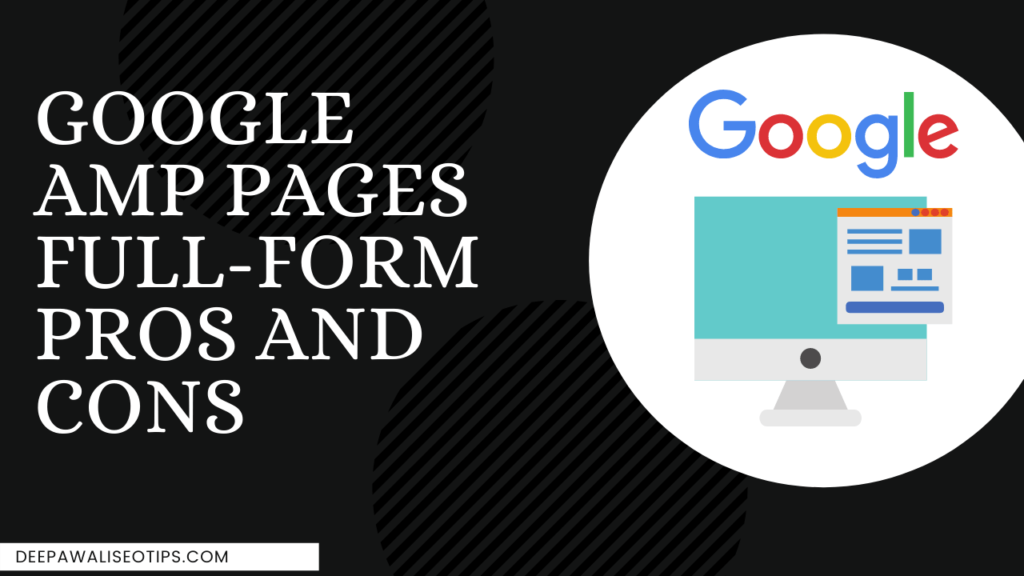
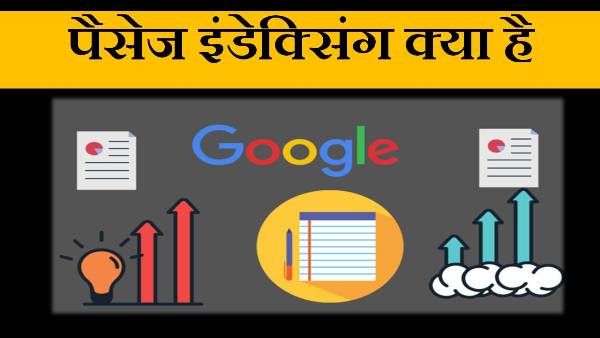
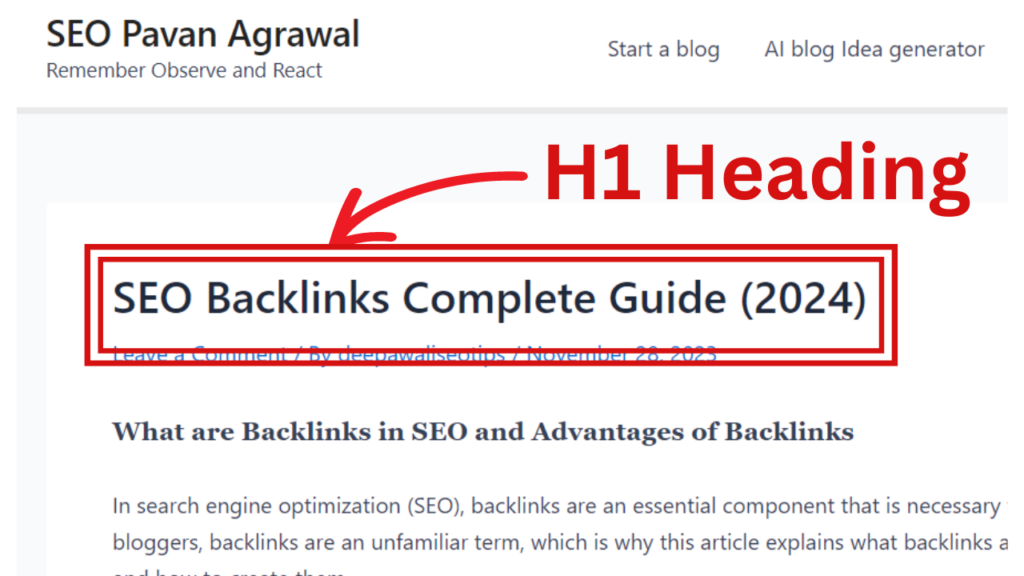
Sir please add some photos of title tag and meta tag.